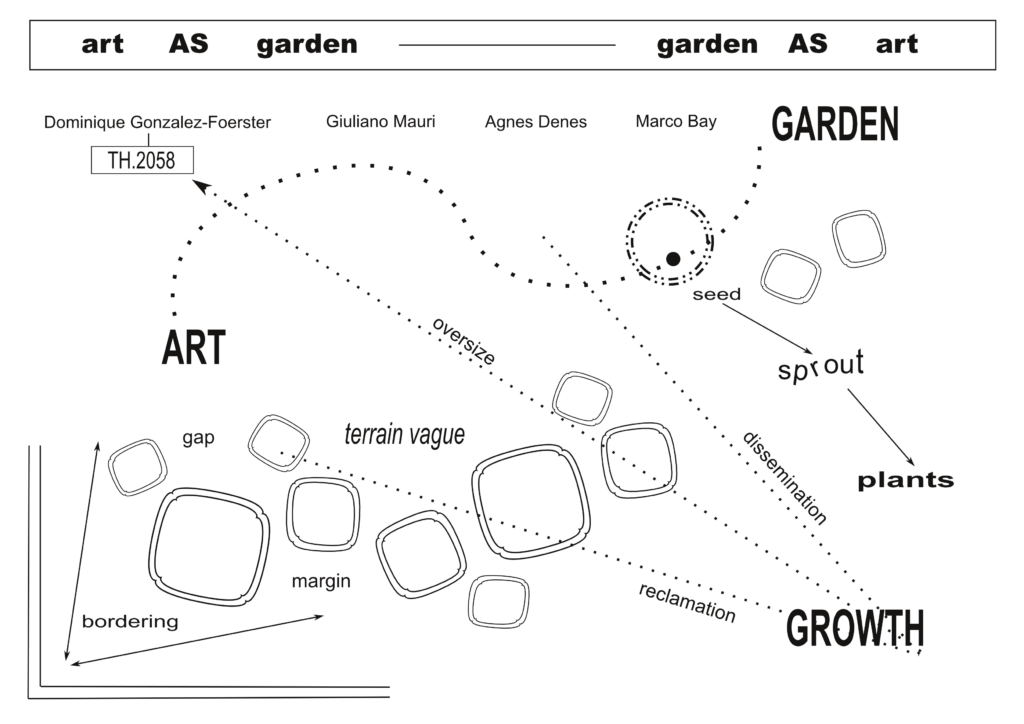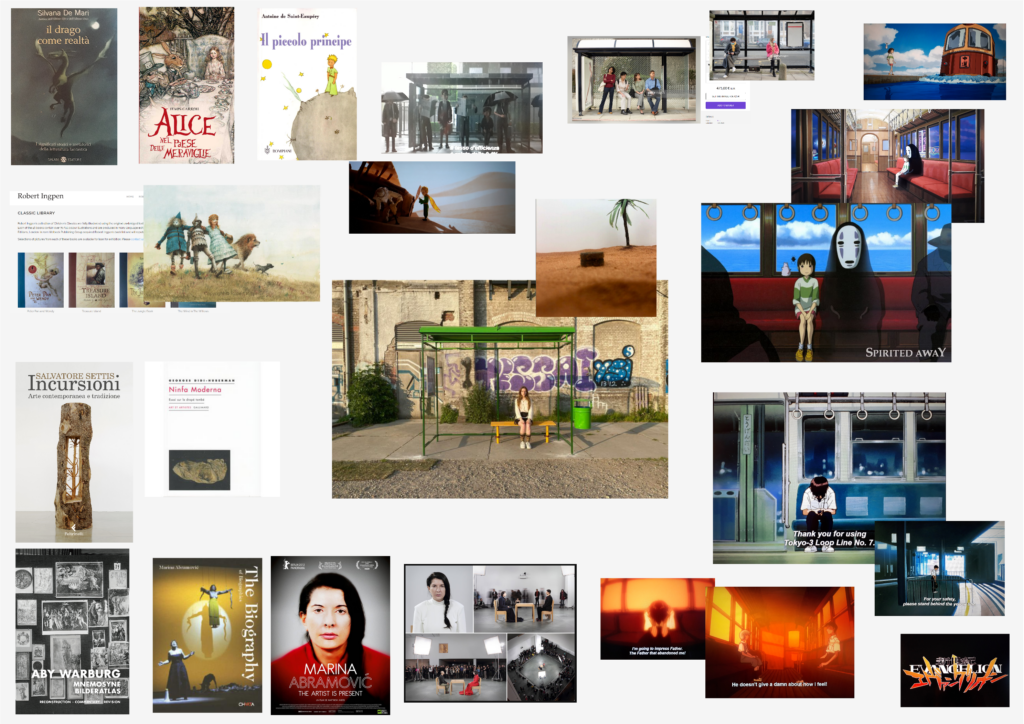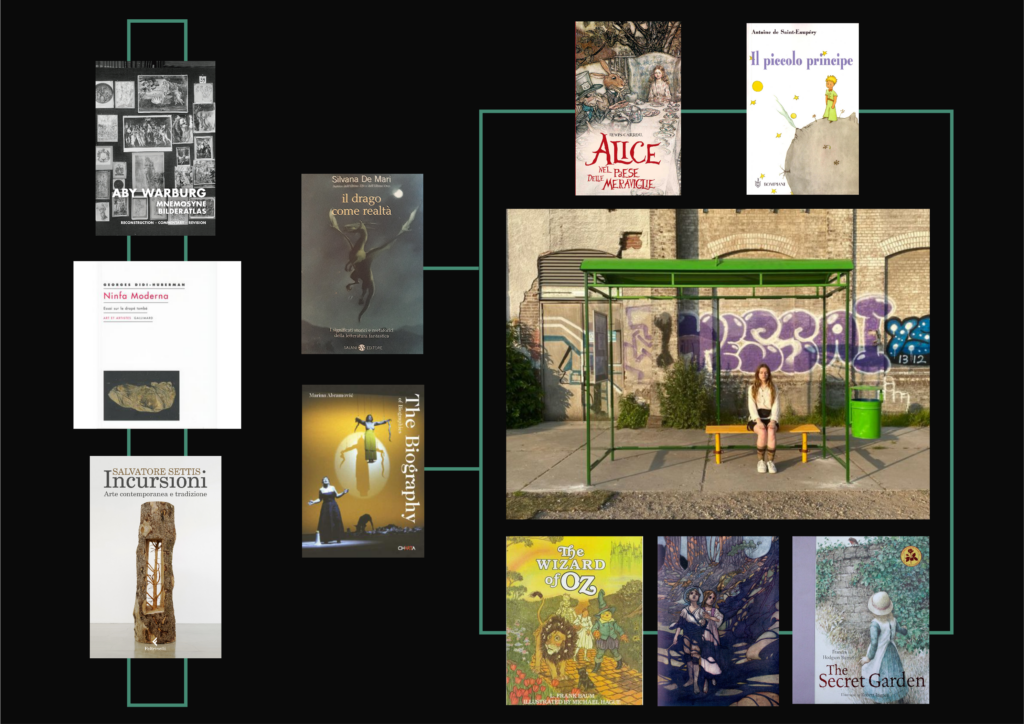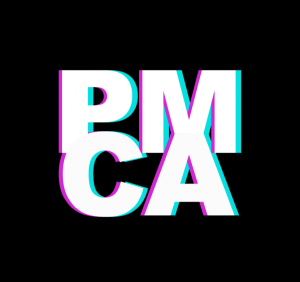Categorie: Uncategorized
an open letter to Anne Jaap de Rapper
Dear Anne Jaap De Rapper,
On the 25th of April, I had my first encounter with From Slumber and have returned around six times since then. The last visit was today, the 9th of May. Over the course of two weeks, I observed the gradual growth your work went through. In this letter, I would like to share with you my reflections on each visit.
On the 25th of April, artificially placed wooden floors of Pitcairn space began to tremble. Dozens of seeds started to climb up in search of sunlight. The space of Pitcairn was yet to be interrupted. Three days later, I recall it being a beautiful, sunny day, in stark contrast to the Dutch weather, I decided to return to Pitcairn. Hoping the sprouting process has begun and with my limited botanical knowledge, I will be able to identify what kind of flora you have picked to exhibit. However, baby sprouts did not uncover their merit that day, piquing an incredible amount of curiosity I have experienced in biology classes years ago. Followed by eagerness, three days later I was standing in front of Pitcairn. At this point impersonating a botanist in order to interpret the state of the flora.
Consequently, the perception of From Slumber shifted. From treating the work as a land-art-appearance installation to focusing on the conditions the organic elements were placed in. How often did you water the flora, does Pitcairn have a ventilation system, and can bees enter the space? When the exhibition is over, what will happen to the plants?
In 2018 Ikea initiated odd advertising against bullying in high schools, conducting an experiment with two identical plants. For a period of 30 days, one plant was given affectionate compliments, while the other was verbally bullied. In the end, the plant that was emotionally neglected shrank in size and lost its green pigment whereas the plant that had been complemented flourished. Although the experiment has gotten some controversies about its validity, my last visits to Pitcairn were dedicated to soothing whispers. Thus, for the fourth round, I brought Jonas Mekas’ poem book and recited How Sweet the Smell of Spring (1948, translated by Adolfas Mekas) to the growing sprouts. Perhaps you read it before, nevertheless, I will share a part of it:
“In the air a cool dampness, the smell of frost and wind,
but soon the water in the ditches will drain, the pastures will dry,
and by the rivers, in the ditches, in wet bogs
will spring up clusters of yellow marsh marigolds.” 1
Regardless, on the fifth visit, the process of reading poetry to already-thriving sprouts was repeated. As though wanting the plants to emancipate while absorbing the poetry of Mekas. Blindly believing Ikea’s experiment was not an advertising hoax and by repeating it onto your work, From Slumber will thrive within the environment of neat gallery space.
Today, however, as the longest sprouts began to bang on the ceiling, it brought back memories of watching Sun Yuan and Peng Yu’s work on display at the 2019 Venice Biennale. The industrial robot relentlessly was sweeping blood-like substance from the flooring of what seemed to be a glass prison. As if the unusual or seldom observed creature was caged for the purpose of demonstration. I remember reflecting on whether it is innate in humans to have a tendency for exhibiting something atypical. To place out-of-ordinary objects on pedestals for the satisfaction of spectators. I wonder, what was your intention?
In such a manner, today’s visit was profoundly different from previous ones. Thinking about Yuan and Yu’s work, Pitcairn appeared as a tiny cage bringing a particle of nature to the eyes of the city dwellers. I stood inconspicuously beside Pitcairn, catching the gaze of passers-by. Did they witness nature’s subtle work taking place in a bustling street?
Finally, yet importantly, numerous visits to observe the untamed transformation of From Slumber allowed me as a silent spectator and on the other hand as a personification of a botanist, to contribute in a small, peculiar manner to its appearance. Establishing a relationship that started from curiosity and evolved into empathy for the little sprouts you have placed in the gallery space. Thank you.
In the end, I am not able to tell if From Slumber flourishment was altered by the conditions in which it was placed, by the poems read to it, or from the eyes of the passers-by.
Kind regards,
Klaudija Ylaite
1 Mekas, Jonas. Idylls of Semeniskiai. Hallelujah Editions, 2007.
Location
Gedempte Zuiderdiep 132
9711 HM
Groningen
Opening Hours
Opened Daily 24/7
Free of charge
© Pitcairn 2022
MAKING A SCENE ANNE JAAP DE RAPPER
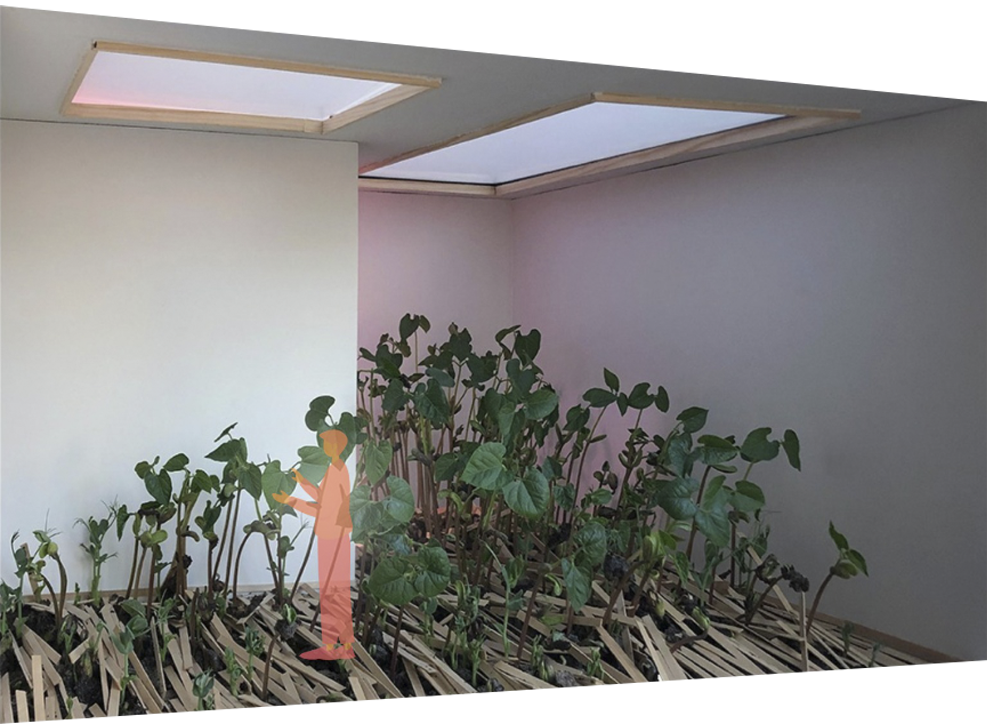
MAKING A SCENE @ ANNE JAAP DE RAPPER
The artist……………………………….. a character played by Anne Jaap
The critic………………………………… a character played by Maartje
The artwork…………………………… a character played by Antonin Artaud
The Scene
The wild pounding rhythm of a long expected shower annoys the window through which a large group of young bean plants look at the people passing by. Their human heads disappear in their human jackets, their human eyes disappear in their man made streets. Everyone’s on their way. The critic leaves the art space, hiding from the rain. But the trees rise up. Water! After the artist watered the bean sprouts in the exhibition, he finds the critic on a terrace nearby, leaving the confined greenery behind. The bean sprouts look worn off. Maybe disappointed. Tired of growing with too little future ahead. Still pretty, in a poetic way, in their search for something to hold on to. The critic found cover on a terrace and is thinking of the poetic beauty of the plants.
The artist: Are you Maartje?
The critic: Yes, I very well am. They shake hands You want to take a look at your plants before we sit down and talk? I just went but…
The artist: No, I also was just there, I‘ve been watering the greens.
The critic seems a bit disappointed and then points upwards to the huge black sunshade onto which the rain beats.
The critic: Seems about right, when it is pouring like this. I guess we missed each other at your artwork then. How are they doing? Sad that the rain doesn’t enter their scene?
The artwork: There is a tangible idea of music where sound seems to enter like a character.
The critic and the artist cannot perceive the artworks’ communications and are thus limited to dialoguing together. They take a seat, order beer and coffee and proceed chatting.
The artwork: The actor is both a prime factor, since a show’s success depends on the effectiveness of his acting, as well as a kind of neutral factor since he is so rigorously denied any individual initiative.
The critic: What plants you got there? I recognized some beans.
The artist: They are all beans, and they are all from my own garden. I chose them because they are strong. Look at one bean, this one small out-of-this world cell. From this sprouts a huge plant.
He adores an unseeable bean between his finger and thumb and shows the imaginary entity in his open hand to the critic
The critic: You think they are aware of what they can do best? To grow, to climb?
The artist: Making more beans, and more.
The critic: But not those in the box over there, though. Their end is near. Shriveling…
The artist: That is right. But I have plenty of them. They got room to sprout here but not to proliferate, they were put in a context – an architectural situation that creates possibilities. He looks over the critic’s shoulder and points See that building? It is not ugly but it is a cage. Created for but one purpose and nothing new or unexpected can happen there. But that shop could be a gallery next year. And this café is not the same as when I came here when I studied arts. This building… It’s done. We need more open space.
The critic: So these beans are not for growing but for meaning-making? Or is that what you do best. Who are you: the artist?
The artist: If you’d like to attach this poeticism to it, you do that.
He shrugs lightly. The critic nods in agreement, writes something down while the artist lights a cigarette.
The artwork: No decor! Objects of unknown form and purpose are enough to fulfill this function. This is a field where there are no exact rules.
A bit uncomfortable, maybe by the defining tone the critic put to it, the artist proceeds his explanation.
The artist: I actually do not like to be an artist. I like gardening more. I want to work together with the material I work with. Furthermore, I really believe things can co-exist or can be true besides each other. Look at me. This body is not one, it consists of millions of bodies. We are driven by bacteria and fungi which process information. For us. With us.
From this idea the artist’s face brightens up. For a short moment he seems to have an internal frolick.
The artwork: Every emotion has an organic basis and we charge his emotional voltage by developing emotions within him. To be familiar with the points of localisation in the body is to reforge the magic links.
The artist sips his milky coffee and gets back to the critic.
The artist: I have always been obsessed with light. When I write I do it by candles or an oil lamp. Through the movement, the flickering, the expanding and contraction, we become able to perceive what is normally hidden in the bright blinding electric light. It is like magic, like a presence to which we are able to connect. Am I wandering off? Sorry. But it’s what I experience and I know I should not go too deep into that. Might get lost.
The critic: I don’t think you are wandering off, you are telling me we are able to perceive the things we learned are not there or shouldn’t be there. What is that you want us to experience, then? You just put beans in a small container. That is sad. If you do not want to be an artist and you do want to garden. Why do you put plants in the box? Is it conceptual to you?
The artist: No, it is plants growing – from slumber. I am reading a book from the beginning of last century about Walden. It is very descriptive, naturalistic. I enjoy this style very much.
The critic: My colleague went to Pitcairn a lot of times to see them develop – naturalism?
The artist: Each and every year I get excited about the world starting to brisk up after winter, but lately this excitement turns into fear more and more. Will trees really grow their leaves again? Is spring going to happen once more? I no longer trust it! As if we go downwards and our world is getting filled up with static and linear shapes while ecologically we are so deprived. The wealth of sorts is diminishing. In my backyard there will be a solar park. I had other plans, an eco cathedral like the one of Le Roy.
Around the two of them the city starts showing its plan: a contest of straight lines and circularity. The artist has his hands bound up in the shapes, pushing and pulling the forms. Struggling, also with his words, he proceeds speaking his anecdote.
The artist: Now I do have contact with one of the people on that project, he likes my plans. While they were to cover the whole field with a black, shiny, panel pattern, I designed a more organic structure. I literally made room, a little space of nothing for new things to grow.
The critic: From what I see, you try to bend the things that are too rigid. How caught up are you?
The artist: It is hard to say. Hands-off is not always the solution. Doing nothing is a lot of the time not the same as giving room. To help I also must dive in and mingle with the garden I care for. Pause You’ve written so little on that piece of paper.
The critic: You say too much I think I agree with. But I do not think you are a naturalist or only a gardener.
The artist: Yes, but where are the words for it?
The critic: Yes, and where are the means? They are kept from us.
The artist: Yes, and we unlearned them, perhaps.
The critic: Yes! Maybe it is not made of words, we just forgot the magic links. That’s why this world is driving us literally crazy. We are nót crazy – the lives we live are.
The artist and critic order another drink, keeping the conversation going by in turn starting a sentence in agreement with the other. When the artist and critic have seperated, the critic walks through the city, murmuring. Suddenly she ends up standing in front of the Pitcairn again. The murmuring creates fog on the window.
The critic: Hey there… Do you think? It’s not naturalism he’s getting at? You are actors as he is too. His art is a Theater of Cruelty. It’s not the art that’s poetic, it is its double. What we call life. Or are you actually the creator? You don’t talk – you tell.
Only heard by the audience, the beans add a Nota Bene.
The artwork: No one knows how to scream any more, since they do nothing but talk, having forgotten they have a body on stage, they have lost the use of their throats. Abnormally shrunk, these throats are no longer organs but monstrous, talking abstractions.
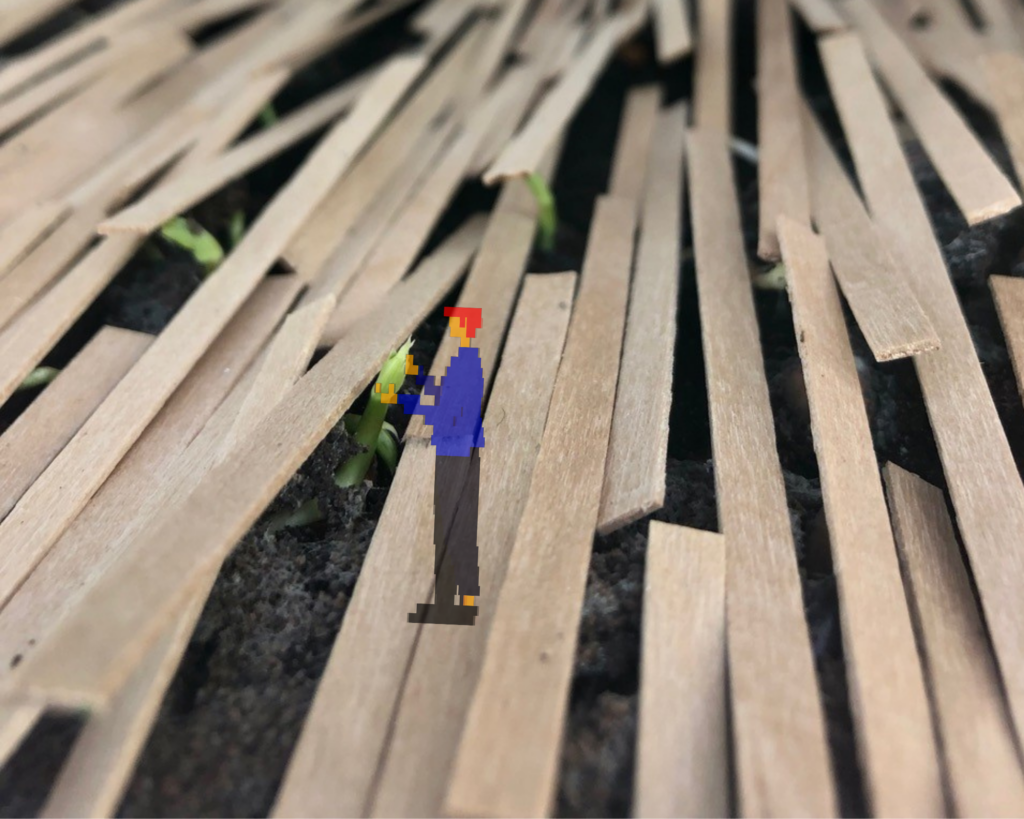
Location
Gedempte Zuiderdiep 132
9711 HM
Groningen
Opening Hours
Opened Daily 24/7
Free of charge
© Pitcairn 2022
Klaudija Ylaite
Klaudija Ylaite
Klaudija Ylaite (Lithuania, 1997) is a multidisciplinary artist who aspires to enter the field of art criticism, particularly focusing on avant-garde studies and the state of artist autonomy in neoliberal settings. She is currently working on her master’s degree in Arts, Cognition, and Criticism at the University of Groningen, and continuing studio-based artistic practices. In her visual language, Ylaite’s attention is directed at representing human conditions, particularly conceptions of birth and death through the mixing of various media.
Location
Gedempte Zuiderdiep 132
9711 HM
Groningen
Opening Hours
Open Daily 24/7
Free of charge
© Pitcairn 2022
Maartje Terpstra
Maartje Terpstra
Maartje Terpstra (Nederland, 1995) is een Groninger kunstenaar +/= activist +/= onderzoeker. Door middel van taal onderzoekt ze de immateriële impact van kunst maken en ervaren. Maartje is een serieuze vlegel. Ze worstelt met grenzen en rommelt met regels.
Wat betekent het om een rol te spelen in de kunstwereld en hoe kunnen we wat bubbels laten barsten? Ik werk aan een reeks teksten waarin ik interviews vermeng met mijn dramatische verbeeldingskracht (en kennis van het dramatische en performativiteit, oké…). Zo creëer ik semi-fictieve gesprekken tussen De Kunstenaar, De Curator, De Beschouwer en De Criticus in de setting van de tentoonstelling waarop ik reflecteer.
Ben jij beschouwer, durf je een scene te schoppen en zou jij een rol wil spelen in één van de scenario’s? Stuur een email naar motief@maartjeterpstra.nl
Adres
Gedempte Zuiderdiep 132
9711 HM
Groningen
Openingstijden
Dagelijks geopend 24/7
Gratis toegang
© Pitcairn 2022
Elisabetta Cuccaro
Elisabetta Cuccaro
Elisabetta Cuccaro (Italy, 1992) writes about art and collaborates with emergent artists. Creating new notions and schemes to describe herself and -beware- anything else is her passion, as much as whatever concerns the epistemologies of art. Her last text After-Taste of Self-Help. Towards a Possible Theory of Exhibition researches about exhibition-making as art practice.
If you are curious to know more about Arcade or if you would like to discuss some topics together, you can contact me! / Wil je meer weten over Arcade of samen wat onderwerpen bespreken? Neem dan contact met me op via email!
You can also find me on LinkedIn and The Dots!
Je kunt me ook vinden op LinkedIn en The Dots!
Adres
Gedempte Zuiderdiep 132
9711 HM
Groningen
Openingstijden
Dagelijks geopend 24/7
Gratis toegang
© Pitcairn 2022
MAKING A SCENE HEIKE WEBER
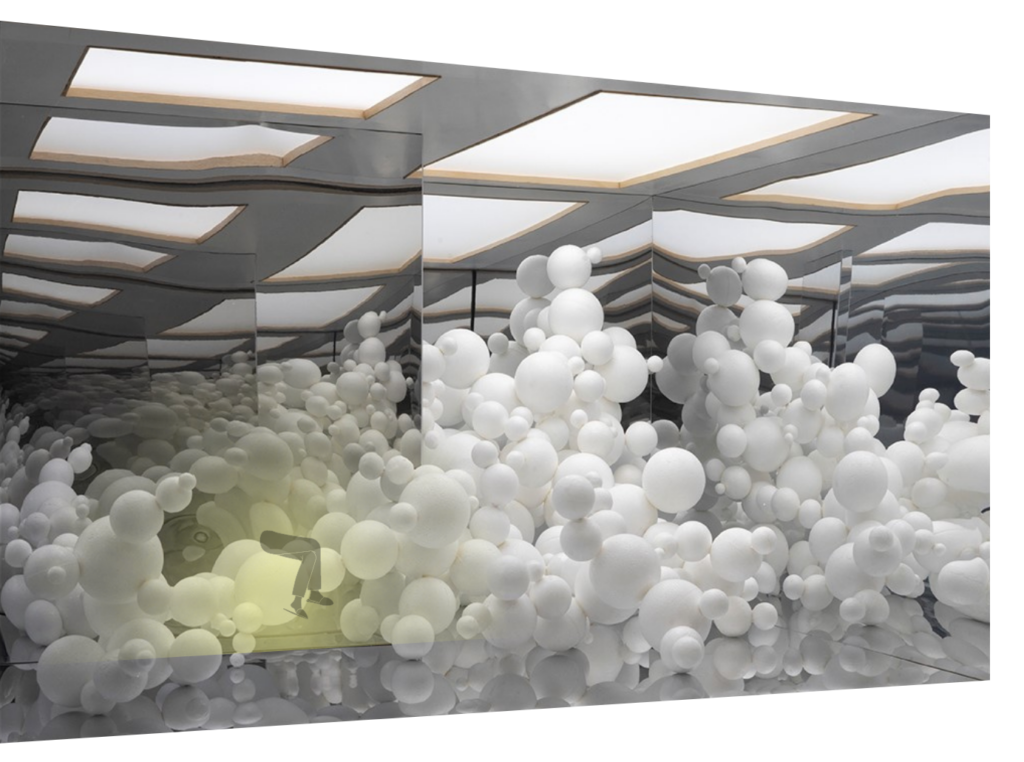
MAKING A SCENE @ HEIKE WEBER
De kunstenaar………………………… een personage gespeeld door Heike
De curator……………………………. een personage gespeeld door Wim
De beschouwer……….……………… een personage gespeeld door Tim
De criticus……………………………….. een personage gespeeld door Maartje
De scène
De criticus: Wanneer ik mezelf zie, stel ik me voor dat mijn ogen, glinsterende ballen, jouw beeld en de blikken van anderen aanraken. Dat is zeer confronterend. Ongemakkelijk, eigenlijk, op een goede manier. Maar ik denk dat het niet goed is als we geen aandacht hebben voor de olifant in ‘de kamer’ – waarmee ik bedoel de ruimte die ons denken is. De moleculen waaruit ik besta zijn elementen die we samen bedachten.
Eerst leerde ik kijken. Ik ben een ontvanger. Ik maak niet alleen objecten, ze vormen me tot één. Een lens, een punt, een positie, een heel specifieke locatie in een veld dat ik nog nooit betrad met mijn alles. Waarom kan ik geen ruzie maken in college als de ideeën me boos maken? Waarom kan ik anderen niet manipuleren, provoceren, ergeren als ik wil dat anderen naast gedachten ook gevoelens hebben? Wat is de methode van voelen… Ik heb geen last van hun gevoelens, ze voeden me. Affectie is de methode. Om jou te ontmoeten. Het doet me pijn dat mensen verlangen afgerond te zijn, alsof ik altijd aan de buitenkant sta om ons binnen te krijgen. Er gebeurt niets, zou je zeggen.
De beschouwer: Het ziet er leuk uit. Pauze Maar ook een soort van vies.
De criticus: Ik voel en hoor het… Luid en duidelijk: hoe we tegen elkaar schuren als getergd piepschuim. Op zoek naar scheurtjes die we open kunnen krabbelen met onze vingers. Onze handen. Lichamen.
Nee, sorry, ik wil geen clichés. We hebben allemaal onze rol te spelen. En de mijne is om te zien, of niet dan? Niet zomaar ontvangen, maar het produceren van zicht. Ik begin graag met Grote Vragen. Niet om anderen af te schrikken of om te wijzen op een cerebrale onmetelijkheid maar om op te schudden… beven. Bzz. Kg. Zo oogst ik tekst voordat ik m’n eigen maak. Mijn eigen, haha! Wat hebben wij toch ook een hekel aan postmodernistische arrogantie, nietwaar? Niet waar?
Ben je wel eens bang voor wat er zal gebeuren met de stukjes die jij van elkaar hebt laten losraken? Krassen aan het oppervlak. Ja. Maar wat als we het binnenlaten? De stapel stenen. Ze lijken klein als kiezels, zoals wanneer je van hoog naar beneden de Engelse kust langsgaat met je blik. De verwarring is er eentje van schaal. Maar het is een enorme berg van gigantische keien en Sisyphus is weg.
De curator: Je moet echt in de avond gaan kijken.
De criticus: Hij vertelt me dat ik je ’s nachts moest bezoeken, maar ik ben al geweest. En toen ik mezelf daar zo zag, terwijl ik worstelde met mijn zicht, zag ik hoe de regels der indeling begonnen te buigen. PWIEEEEEJP. Ik wreef mijn wang over het glas. Met mijn oogleden kuste ik de atomen.
De kunstenaar: Ga nog een keer naar de pitcairn als het donker is. Ze lacht genereus Dat zou geweldig zijn.
De criticus: Ik zal het doen – vanavond nog. Maar ik ben nu al in de war. Kijk mij nou tegen mezelf praten. Laat me je vertellen waar het van gemaakt is, want zij vertelde het aan mij en nu wil ik het vertellen aan jou. Deze verwarring ligt helemaal aan mij. Ik concentreerde me te veel. Alsof ik slechts een waarnemer was, enkel een individu. Oh, maar wat houd ik van het idee om te dromen hoe het zou zijn om naar binnen te gaan. Ik hoop dat je me opnieuw laat beginnen.
Hoe kunnen we iets creëren dat ons verrast? Pauze Waar is deze wolk van gemaakt?
De kunstenaar: De oneindige wolk is het wonder van het leven. Ik ben geïnteresseerd in zijnsvormen die zweven, het uiteenvallen van structuren die solide leken.
De beschouwer: Vies, zeg ik je. Het is kankerachtig. Zie je die uitstulping aan het einde? Waar gaat het heen? Ik voel me ongemakkelijk bij het idee het aan te raken.
De criticus: Ik geloof niet dat we het zouden kunnen aanraken. Dat maakt me verdrietig. Geisoleerd. Ik raakte gefrustreerd maar dat komt omdat ik bang werd. Het nodigt de geest uit en als je niet oppast, ga je weg voordat het lichaam begint mee te doen. Pauze Denk je dat een innerlijke wolk gedeeld kan worden met anderen?
Nu probeert de kunstenaar de criticus fysiek in haar beeld te verwerken.
De criticus: Betekenis geven en moleculen, de buitenlaag is je bedachtzame bewoording, daarbinnen de voedzame affectie en verlangens. Keer je naar binnen – als het donker is. Tast toe.
Adres
Gedempte Zuiderdiep 132
9711 HM
Groningen
Openingstijden
Dagelijks geopend 24/7
Gratis toegang
© Pitcairn 2022
An open letter to Heike Weber
Dear Heike Weber,
On the 10th of March, after visiting the annual third-year exhibition at Academy Minerva, two fellow artists and I have stopped by Pitcairn museum space, where your work Inner Cloud was on full display. Granted by the absence of light during late evening hours we were able to see the installation without being obstructed by sunshine or raindrops. The transformation of the space’s walls into a labyrinth of mirrors generated an immediate sense of bewilderment. Making us wonder what was there in actuality. I remember instantaneously being intrigued by the notion of fractals. Creation of infinite universes. Yet, the stillness of the work made my wandering mind get fixated on the color and the form of your sculptural installation.
There is something distinct about the color white. Particularly in terms of how we comprehend it in degrees of symbolism. As well as, how we digest it. I would like to share with you what first comes to my mind when thinking about the phenomena of white color. In the science of wavelengths, white light breaks down into a spectrum of hues. As a color that represents the beginnings of other colors. Analogously, in Western beliefs white has been associated with the emergence of life, purity, and innocence. This can be found throughout the history of arts, particularly in the renaissance period, where Archangels were typically depicted with purely white wings, holy personas dressed in white gowns, recurring portrayals of a white lamb, at last – unmarried women in long white dresses.
The associations that the color white induces in our cognitive abilities to conceptualize it could go on long personalized lists, however, for today a symbol of the white flag would be my favorite one. I could see all of the aforementioned associations in your work, yet, there was something intimate Inner Cloud signified to me.
When I was around 6 years old, I started to have a reappearing dream. A dream of a pristine white skin/fur creature, something on the lines of a greek sculpture if somebody would have blown a soul in it and transformed the figure into an unrecognizable being. I can no longer recall the exact shape it had but the smoothness of its surface has stayed in my memory as something outside human language. The first time it came to visit, it asked me to swear I will not say a word to anyone after waking up. I had to swear it on my waking life. In exchange, I would be rewarded with the creatures’ visits. Or, at the very least, I believed it must have been a delightful experience to have a dream visitor with such a faultless physique.
Regardless of my swear made somewhere 20 years ago I am sharing this memory since after seeing Inner Cloud, I suddenly remembered the creature. Perchance, it got evoked by the visual overwhelmingness of the color white. Your scrupulously placed orbs with the illumination of mirror walls appeared as if the creature has gotten a new form. An abstraction of who used to have a solid shape. Now is split into molecules. Facing its metamorphosis in the eyes of galleries passers-by. There was a relief I felt seeing what you have done with its form. As if you have renounced the reign it had over a child’s dreams years back. Took its material form and molded it as wished.
Nonetheless, the link between my dream recollection and your work has elicited something relevant in today’s context. It feels that you have touched upon my current mind clouds. Which, for the past month, have been overtaken by the hope of hearing truce and therefore seeing a symbol of a white flag.
You might wonder, how does my dream, your created world, and the current state of Europe have in common. Well, I will answer it bluntly, altered perception. The awareness of surroundings to the degree invisible to a human eye. As if Inner Cloud has enhanced a minuscule view – an understanding of one living/breathing/stiving organism. Making me realize that the dream creature was not only a construct of my subconscious mind but was also made up of the same molecular structure that I am. And, in a microscopic view, a person striving to survive a few thousand kilometers away would be the same as I am. Therefore, what happens in the beforementioned scenarios of associations with the color white, the dream, today’s reality is the constant flux of the molecules. Or, as I like to imagine, a dance of units.
Although, from the moment of seeing your work I was aware the assigned meaning stems from morphing spaces and creating illusions, the stillness, and hence the contextual openness your work has given, prompted me to recall a personal childhood event and ponder feelings on Europe’s current status.
In the end, I like to think about Inner Cloud as something meditative for the mind to wonder.
Yours,
Klaudija Ylaite
Location
Gedempte Zuiderdiep 132
9711 HM
Groningen
Opening Hours
Opened Daily 24/7
Free of charge
© Pitcairn 2022
Notes on inner cloud
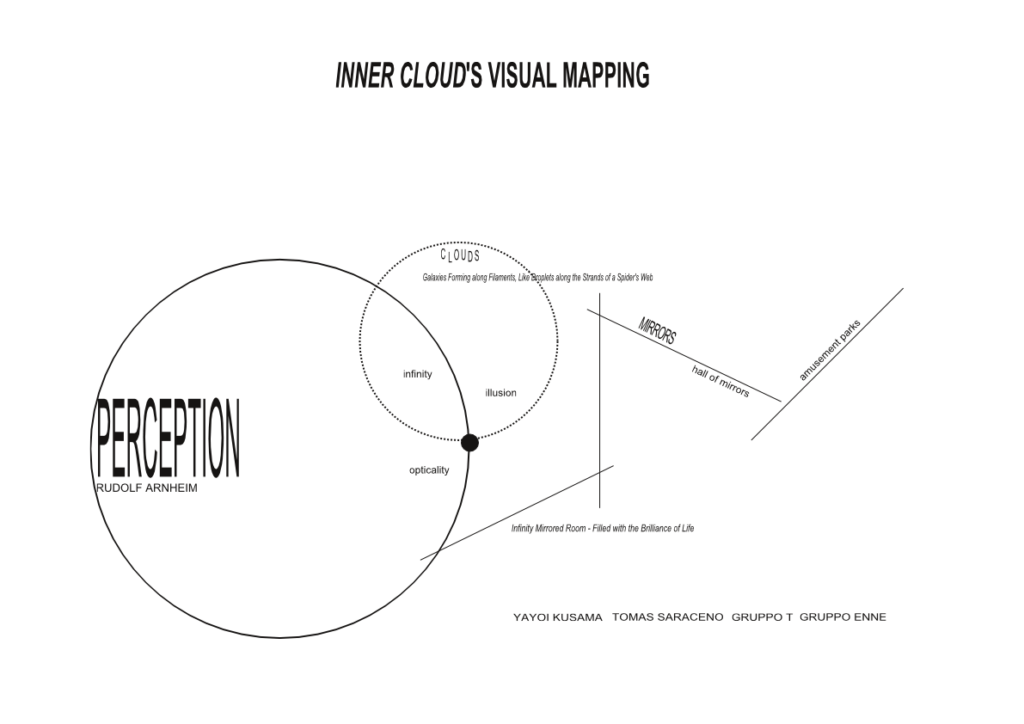
NOTES ON INNER CLOUD
reading time: 4 minutes
This short text aims at accompanying the mind map above, which is nothing more than a visualization of the main topics and references that came to my mind while thinking of Heike Weber’s Inner Cloud. As usual, I did not see the work itself (even though I am currently in the Netherlands), and my wanderings are based on online images.
I wanted to share with you some observations, and one question has kept popping up throughout the development of this material: what the role of this text should be. The neat, essayistic product I am used to deliver when writing about art is quite far from what this format supports. Honestly, it feels like what I am up to is sharing the backstage of my reflections, and presenting the process itself. The issue is: does the process without its final stage provide an interesting reading? Or does the lack of a final and rounded reflection take away value and possible relevant insights? To posterity the arduous sentence; to me, some notes into my contribution’s working.
TROPE’S SHORTCOMINGS: FIGURATION VS ABSTRACTION
When approaching a subject, the first question one should ask is: what method better suits the undertaking? As much as I think any perspective can be valuable for the understanding of a matter, I do question if some offer a better fit. There are many possible readings and theoretical frameworks that can be put into service; what element should make us weigh one against others? My personal bible for contemporary art, the volume Art Since 1900: Modernism, Antimodernism, Postmodernism by authors Foster, Krauss, Bois, and Buchloh starts presenting four main theoretical tools or perspectives: the psychoanalytical, the social, the structuralist, the post-structuralist (if I remember correctly). In my case, last month I introduced you to my loosely Warburgian approach of visual linkages, in order to define a trope and its inner content.
With Inner Cloud, an issue emerged: what is a trope without a figuratively based gesture or pose? Are there remnants that I should catch, a running-after-midnight Cinderella? What to do with a work which belongs to the stream of abstract art? Poor of validly elaborated answers, here is a short list of points.
First of all, associations – better thought of as the associative method – are always the principle underlying my thinking process, as well as they are at the base of the visual map. Plus, the visualization of these associations is translated as the map-shaping itself. Offering a proper guideline, other works of art can be found written in italics, while artists (as well as art movements or art critics) are written in capital letters. Other themes and topics are spread within the geometrical material. The interrelation of forms and writings is what gives life to the map, a possible visualization of the relationships between content-related units.
Secondly, the map – something visually organized – shows no other picture (for example of related artworks). The abandonment of other images to create the map highlights the pictorial nature of the map itself (here and now treated more as an image than before), and depends on considerations about image’s status, between copyright, usage terms and nature.
A third point concerns the field extension of image associations. A work based on abstraction calls for referring to the art field more than figuration. When seeing a recognizable figure, such as Postolle’s, the mind looks for similar ones, in general, from advertisement to anime series. With abstract works, my mind could not but gravitate heavily towards the planet of art history. As much as I am aware of other possible sources, the themes, images and discourses that came to me were highly related to art critical traditions (as the mere antithesis of abstraction and figuration itself).
SURFACE AS SPATIALIZING MEANS: AN ILLUSION OF INFINITY
Beyond these methodological struggles, if I can call them like that, what could be the “content” of my reflections around Inner Cloud? I do not want to spoil other unfoldings, by limiting possible multiplications between the presented factors. Still, I want to point at the triad of themes this work built upon: that of opticality, infinity, and illusion. The work breaks the limited room of the Pitcairn museum, offering the illusion of infinite space, a never-ending reflection, which, even if spatially defined and limited, brings forth infinity as a graspable and perceivable dimension. Surfaces have the fascinating ability to be at once shallow and deep, and with the right optical tricks, a 2 dimensional work becomes 3D. Still, this transformative power could just be that of trompe l’oeil. But in this case, surfaces give life not only to an illusion of a three-dimensional space, but of infinity itself (somehow a-dimensional). I remember the amazement felt as a child while finding myself between two mirrors, the awe provoked by seeing the corridor of infinite replicas opened at my sides. Somehow, space becomes the actualization of distancing, where the recursivity of the image mirrors that of the mind. Such distance reminds of that between phenomenon and noumenon. Knowledge is built on surfaces and their illusions, as well as on the mesmerizing feelings they engender (from Plato’s cave to mirror neurons). Both mirrors and clouds create imaginative environments, and the potential of putting together their perceptual powers breaks limitations. A drawing becomes an installation, as well as space becomes infinity.
Elisabetta Cuccaro 2022.
Location
Gedempte Zuiderdiep 132
9711 HM
Groningen
Opening Hours
Opened Daily 24/7
Free of charge
© Pitcairn 2022


